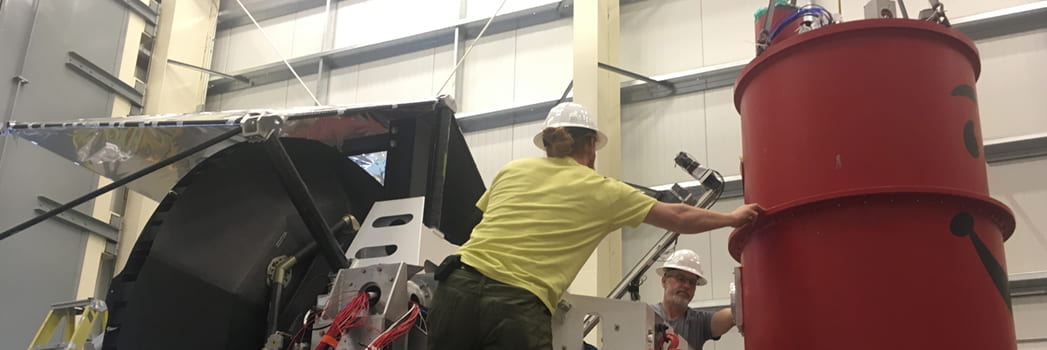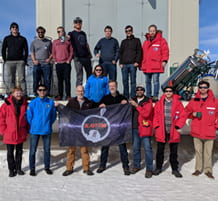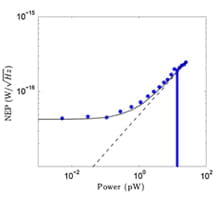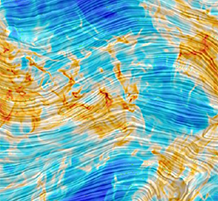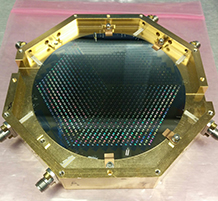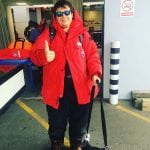March 2024 – Our team has published a paper in the Publications of the Astronomical Society of the Pacific detailing the capabilities of our proposed new mission BLAST Observatory, that will fly 8274 MKID detectors on a Super Pressure Balloon.
BLAST-TNG was a telescope designed to observe the polarized thermal emission from interstellar dust. Its aim was to follow up on the success of BLASTPol (see “Publications”) by collecting data on the properties of dust and the role of magnetic fields in the interstellar medium through a wide range of densities. The BLAST-TNG team had hoped to produce several-degree-scale polarimetric maps at sub-arcminute resolution, making simultaneous measurements in 3 broad bands centered at 250, 350, and 500 microns, with a significant fraction flight time (25%) allocated to shared risk proposals from the community. Unfortunately, in 2020 the first flight of BLAST-TNG was cut short and the payload was destroyed on landing. The BLAST team has proposed a new, more powerful mission called BLAST Observatory (Coppi et al. 2024; Lowe et al. 2020; see “Publications”).
Sensitivity forecast paper for BLAST Observatory published in Publications of the Astronomical Society of the Pacific
In support of our team’s new proposal to build and fly an upgraded version of BLAST-TNG that we call BLAST Observatory, we have published a study of the mapping speed that can be achieved this Super Pressure Balloon mission, which incorporates 8274 Microwave Kinetic Inductance Detectors operating at 175, 250, and 350 microns. We describe the scientific motivation, the proposed implementation, and the forecasting methods used to predict sensitivity. The reference is:
BLAST-TNG Initial Results for HII Region RCW 92B
 The January 2020 Antarctic flight of BLAST-TNG made the first observations using microwave kinetic inductance detectors (MKIDs) from a NASA sub-orbital platform. Despite the very short flight duration, we obtained valuable test data including observations of RCW 92B. The left and right panels, respectively, show initial results at 350 and 500 microns. In each case, we show (in blue) the signal collected by just one MKID during a single sweep through this double-peaked Galactic HII region. The same plots also show (in orange) the corresponding profile of the target from maps made by ESA’s SPIRE/Herschel instrument. The BLAST-TNG sweeps shown here each correspond to two seconds of data. We are using these and other flight data to characterize the performance of our detectors and optics. See publications section for links to recent papers.
The January 2020 Antarctic flight of BLAST-TNG made the first observations using microwave kinetic inductance detectors (MKIDs) from a NASA sub-orbital platform. Despite the very short flight duration, we obtained valuable test data including observations of RCW 92B. The left and right panels, respectively, show initial results at 350 and 500 microns. In each case, we show (in blue) the signal collected by just one MKID during a single sweep through this double-peaked Galactic HII region. The same plots also show (in orange) the corresponding profile of the target from maps made by ESA’s SPIRE/Herschel instrument. The BLAST-TNG sweeps shown here each correspond to two seconds of data. We are using these and other flight data to characterize the performance of our detectors and optics. See publications section for links to recent papers.
Update on initial flight of BLAST-TNG
 At 6:10 PM local time on January 6 of this year, BLAST-TNG began its first flight. Most of our systems worked flawlessly and we carried out the first-ever observations using microwave kinetic inductance detectors (MKIDs) from a NASA sub-orbital platform. However, a mechanical failure occurred 14 hours into the flight, preventing us from pointing the telescope and severely curtailing our observing program. We then brought the experiment down, landing on the Antarctic plateau a few hundred km away. The recovery operation is underway, and most components of the experiment have been brought back to McMurdo Station. Some critical parts are still at the landing site awaiting recovery, hopefully any day now. Despite our disappointment at not achieving our goals for the flight, our team is eager to analyze the data we did collect and begin rebuilding for future flights!
At 6:10 PM local time on January 6 of this year, BLAST-TNG began its first flight. Most of our systems worked flawlessly and we carried out the first-ever observations using microwave kinetic inductance detectors (MKIDs) from a NASA sub-orbital platform. However, a mechanical failure occurred 14 hours into the flight, preventing us from pointing the telescope and severely curtailing our observing program. We then brought the experiment down, landing on the Antarctic plateau a few hundred km away. The recovery operation is underway, and most components of the experiment have been brought back to McMurdo Station. Some critical parts are still at the landing site awaiting recovery, hopefully any day now. Despite our disappointment at not achieving our goals for the flight, our team is eager to analyze the data we did collect and begin rebuilding for future flights!
We’ve begun our 7th launch attempt!
We carried out six launch attempts between December 25 and January 4 – these six were canceled due to high or unsteady low-level winds. Photo is from December 28 when we made it as far as the launch pad. The stratospheric circulation pattern is expected to die out in a week or two, so fingers crossed for a launch very soon.
BLAST-TNG passed “compatibility”!
We attached our experiment to the NASA launch vehicle and worked with NASA engineers to look for interference between NASA’s communications and control systems and our experiment’s functions. No problems were found – we are flight ready! Now all depends on the weather. Fingers crossed for a launch opportunity soon!
Successful Communications Tests

BLAST-TNG goes outside for communications tests – which were successful! Our team has been very busy over the past several weeks. We’ve cooled our 850 lbs. cryogenic polarimeter (red object in photo), mounted it back onto the telescope, and carried out numerous systems tests. We are nearly flight ready, and the one experiment ahead of us in the line-up – called superTIGER – was successfully launched yesterday. Fingers crossed for good launch conditions!
First View of Antarctica in Almost a Year
 First BLAST-TNG collaborators arrive in Antarctica to take the experiment out of storage and prepare it for a December launch! This photo, taken from the C-17, shows our team’s first view of Antarctica in almost a year. Its been a long wait following last year’s bad weather and four scrubbed launch attempts, and we are all eager to get out to the Long Duration Ballooning site and get to work.
First BLAST-TNG collaborators arrive in Antarctica to take the experiment out of storage and prepare it for a December launch! This photo, taken from the C-17, shows our team’s first view of Antarctica in almost a year. Its been a long wait following last year’s bad weather and four scrubbed launch attempts, and we are all eager to get out to the Long Duration Ballooning site and get to work.
Antarctica, here we come!
Ian and Nate were the first of the BLAST team to arrive in Christchurch, New Zealand! The first order of business is a trip to the United States Antarctic Program (USAP) clothing distribution center to get all the extreme cold weather (ECW) gear needed for living and working in Antarctica!
- Ian shows off his full ECW gear
- Nate is pretty psyched that the jackets have fancy name tags
- There are lots of types of gear available depending on your job on the ice
- Everybody gets a pair of snazzy orange bags with all your gear
Team Photo
Yesterday was the busiest day here at CSBF for the BLAST team, so we decided to take a group photo of almost all the team. Not only the team was almost completed but also BLAST starts to be almost all mounted, we added the scoop and the readout system on the gondola. It was another great day for the team and we are making significant progress here.
-Gabriele
The mirrors are on!!
After several days that Nate and I discussed about writing a blog and publishing more photos of our life in the high bay at CSBF, I finally found 10 minutes to do so. After 2 weeks we did a lot of progress, and I think that there is no better way to start our blog that publishing a time lapse of a critical day like today. We transfer liquid helium, so now Layla is cooling down to 4K, we installed the mirrors and for the first time we rotate them. It is a great achievement and everything went fine.
In the future, I will publish more photos than the one that you see on Instagram.
-Gabriele






